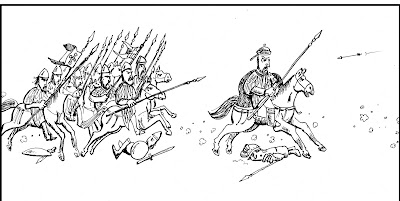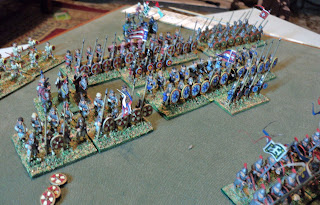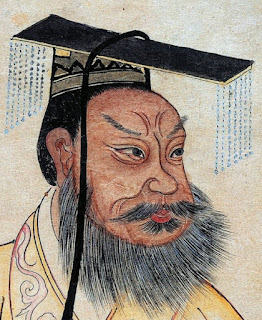The Second Sino-Union War having concluded with a hard fought and dearly bought Union victory, I thought here that I would make some comments on the running of the campaign, the rule set used, and some of the decision-making. One thing that might be worth mentioning, though, is that had the copy of 'Trebian's' Taiping Era arrived before the campaign was fairly begun, that would have been the basis of the battles.
 |
| Battle of Yangzigu |
I think it appropriate here to paste in the comment of the originator of the
Woodscrew Miniature Armies blog and its world, and some of my thoughts in reply. My discussion of firepower, factors and numbers didn't really complete the ideas I had of running 'paper battles'.
Tony Adams sent -
Yet another great battle report and at last, a final Union victory !!!!! This whole campaign has not gone the way I expected but that demonstrates clearly how one sided my view of the Union has been till now. There is much for me to digest before I write the next chapter of the history of Tian although I know for sure that the Union will not take comfort from this victory, it came far too close to defeat for that to happen. Thank you very much for wargaming my Imagi-Nations, I am honoured you felt them worthy. Regards.
 |
| Battle of 'Weshall Pass'. |
My reply:
Hi Tony -Did you feel a sense of relief at the final outcome? I have no doubt so did the good burghers of Denver and hinterland - even the editor of the 'Denver Discourse'! Tenth Army will return home as heroes; its commanders, especially Jackson and Bidwell, as leaders of heroes. And heroes are heroic according to the quality of their adversaries.But this campaign narrative I wanted to take an occasional glimpse across to the 'other side of the hill'. I began quite early to see T'ai Kun Wu as tough and determined - a man of moral strength, and fiercely loyal to his master, the Emperor. Such a one was capable after three heavy defeats, and in the face of such awesome firepower, to mount a strategic offensive and come within an ace of winning the campaign, or at least 'squaring the honours'. I do not believe the campaign was quite as one-sided as it might at first reading appear. Clearly YOU didn't think so! One major defeat to Tenth Army would have ended the campaign pretty much forthwith.You don't war game as such, but you might consider 'randomising' the battles in some way - what I call 'paper battles'. One possibility is to assign a 'firepower factor' for battalions and support weapons:S/B muskets FP=1M/L rifles FP=2B/L rifles FP= 4Magazine rifles FP=7 (say)Machine gun units FP=6Flying and light artillery FP=4 (S/B) or 6 (Rifled)Heavy Artillery FP=6 (S/B) or 8 (Rifled)A Union brigade of 6 battalions, MG company and light artillerywould have a FP factor of 6 x 7 + 7 + 6 = 55.A Chinese Regular unit, 6 'battalions' with M/L rifles and no support weapons, would have had a FP factor of just 6 x 2 = 12. These numbers are fairly arbitrary, arrived more by quesswork than anything else.But on this basis, then, the Union Tenth Army, less 40 Brigade, would have had an overall FP factor of 237; the Chinese Army a total FP factor of 170. Quite a difference, but the disparity in actual numbers - at least 3 to 1 - would have in fact reversed the disparity of force.Now, these numbers are pretty arbitrary. But a little bit of Mathematics (based on Lanchester's Theory of Battles) suggests that even with such an enormous disparity in 'unit' firepower, the Tenth Army could not possibly have handled the Chinese Army all at once. Some very rough calculations indicate that Tenth Army could take on - at equal terms - a Chinese Army (per this campaign!) about double its numbers.Well, that it had to do, at Camp Supply, and look how close that was!Now that the Second Sino-Union fighting war is over, no doubt the diplomats will be settling the peace. Thank you for allowing me to carry on the fighting part of this campaign. Something different, and I'll be following the 'future history' of Tian with great interest.Cheers,Archduke Piccolo
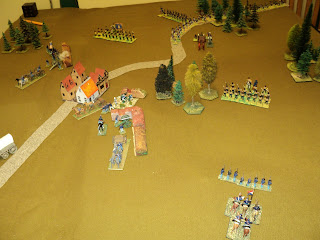 |
| Brig. Bidwell's delaying action |
The Woodscrew Campaign Battles Rule set
This was hastily cobbled together, and much simplified, from my own 'Old School'
Bluebellies and Graybacks ACW game set. I had to add in factors for magazine rifles and carbines, for breech-loading rifled artillery, and for machine guns. Not having any Maxims, I used Gardner/ Nordenfeldt models.
1. Movement:
1.1 Artillery:- Flying (Horse) and Machine Guns: 9" (22.5cm)
- Light and Heavy: 6" (15cm)
- Manhandled (except heavy): 2" (5cm)
1.2 Cavalry:- Line: 6" (15cm)
- Column of squadrons: 9" (22.5cm)
- Route Column: 12"
1.3 Infantry:
- Line: 4" (10cm)
- Assault Column: 6" (15cm)
- Route Column: 8" (20cm)
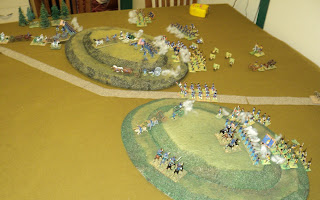 |
| Battle of Liaoyang |
2 Shooting:
2.1 Artillery:Ranges: 0-4" ....... 4+-8" ........ 8+-12" ...... 12+-16" ... 16+-20" .... 20+-24"
0-10cm . 10+-20cm . 20+-30cm . 30+40cm . 40+-50cm . 50+-60cm
S/Bore DR=6..... DR=5 ........DR=3......... DR=2....... DR=2 .........N/A
Flying DR=5.....DR=4 .........DR=3 .........DR=3....... DR=3 .........N/A
Lt Rifle DR=5.....DR=4 .........DR=3 .........DR=3........DR=3 .........N/A
Hv Rifle DR=5.....DR=5.........DR=4 .........DR=3........DR=3 ..........DR=3
2.2 Other shooting:
Weapon.......Volley Group ...... Ranges: 0-4"(0-10cm)... 4+-8"(10+-20cm)... 8+12"(20+-30cm)
S/B musket 6 figures DR=4 N/A N/A
M/L rifle 6 DR=4 DR=3 N/A
B/L rifle 4 DR=4 DR=3 N/A
Magazine rifle 4 DR=5 DR=4 N/A
Mag. Carbine 4 DR=5 DR=4 (up to 6"/15cm only)
Machine gun 1 model DR=5 DR=4 DR=3
Wagons/Train 1 model DR=2 DR=2 (unless armed with S/B musket)
Die Range = the maximum die score that is counted. See 4. Method.
Fractions of volley group take the appropriate fraction of hit scores within Die Range.
2.3: Halve 'hits' for targets that are fortified, or in cover. For heavy fortifications, reduce the Die Range by one, before halving hits.
2.4: Halve 'hits' (again) for targets that are 'dispersed': skirmishers, artillery, routers.
 |
| Battle of the Turnoff Road |
3. Close Combat:Infantry: Regulars: Volley Group = 4 figures
Conscripts and irregulars: VG = 6
Cavalry: Regulars: VG=3
Conscripts and irregulars: VG = 5.
Artillery, Machine Guns, Wagons: VG=1 model
Halve 'hits' when attacking fortifications or buildings.
Halve 'hits' if skirmishers or artillery in close combat.
4. Method:
1. In all small arms fire and close combat, roll 1D6 per volley group.
2. For each die rolled, all scores equal to or below the 'Die range' (DR) count towards 'hits' on a given target. Higher scores are ignored.
3. Total up all hits on a given target.
4. Divide this total into groups of eight plus a further group of any remainder
5. For each 'group' roll that number of dice (8, or the remainder).
6. For each group reduce duplicates to one die.
7. For each group, the number of dice remaining (i.e. each distinct score) counts as a casualty on the target. Note that for groups of 7 or 8 'hit' dice, there will always be duplicates.
8. Remove casualties. (Yes, I am THAT 'old school'!)
 |
| Battle of 'Camp Supply' |
5. Morale:Cavalry and Infantry units are 'in hand' whilst still retaining at least 50% of the strength it had at the beginning of the battle. Once reduced to below 50%, the unit retreats in rout. This does not apply to MGs or Artillery.
Once an army has been reduced to below 50% of its original strength during the course of a battle, it must retreat, having been defeated. If both armies become so reduced in the same turn, then both must retreat. If, the enemy having been defeated already, an army's strength falls below 50%, this army need not retreat, but halts all advances against the enemy.
 |
| Battle of 'Camp Supply' |
6. Campaign:
6.1.Battle Losses:All battle losses are regarded as killed, wounded, missing, or otherwise no longer 'with the colours'. At the end of a campaign battle those losses are divided into sixths:
3/6 (one half) are killed or wounded - a permanent loss to the army
1/6 (one sixth) are 'stragglers', which return to the colours post battle if the army wins the battle; or are POWs if the army loses. They are part of the 'casualty count' only if the army lost the battle
2/6 (one third) are 'stragglers' who, for any number of reasons, left the colours during the course of a battle. These return to the army's strength (win or lose) after the battle.
 |
| Battle of Xiaozheng Creek |
6.2 Campaign outcome:The War was to conclude when one or both armies fell below 50% of the numbers with which they began. The Union did receive reinforcements after the first few battles - roughly 40% of their original strength. This was assessed after the final adjustments of battle losses for stragglers etc. Added together, the establishments of Tenth Army, minus 40th Brigade, but reinforced by understrength 17th and 19th Brigades came to about 181 figures (slightly more than 30,000 troops altogether according to the scale I had set: 3 figures to 500 men). The Chinese army overall began with 434 figures - a little over 72,000, all up.
After the Battle of Camp Supply, the Chinese army had fallen to just below 50%; the Union almost, but not quite, reaching the same situation. Had the Union lost, or even merely tied the battle, Tenth Army would have been forced to retreat, as indeed would the Chinese. There was just a handful of figures in it, one way or the other. However, given the result, it seemed to me reasonable to fight one last battle, with the Union attacking, and the Chinese army, its morale shaken, unable or unwilling to mount counter-attacks other than to recover lost ground. That completed a successful campaign for the Union.
* * *
This rule set was intended to offer very fast play, even with a lot of figures on the table. No doubt it could be improved with refinements, and they did favour the Union quite a bit, but I felt that that was only to be expected, given constraints upon the equipment available to the Chinese. As it was I had to persuade Tony to allow the Chinese some cavalry, however slender the numbers, basic their training and rudimentary their weapons.
For most of the battles, the Chinese actions and reactions were 'programmed', pretty much.
In my response, I suggested to Tony that he might want to 'randomise' his battles slightly. I made a start, but as this posting is already sufficiently long, I'll leave it for another occasion.
